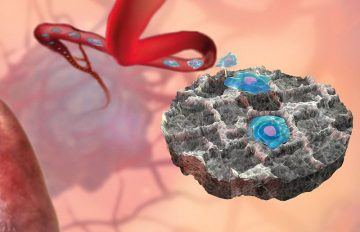Elizabeth Svaboda in Nature:
 An animal study has shown that implanting a tiny, cell-attracting scaffold below the skin can help physicians to track cancer progression, potentially reducing the need for tissue biopsy. Researchers have observed that before malignant tumours spread from their primary location to other parts of the body, they deploy circulating tumour molecules that suppress the body’s immune response — a strategy that makes it easier for the cancer to infiltrate distant organs. Bioengineer Lonnie Shea at the University of Michigan in Ann Arbor and his team developed a scaffold that could detect and trap circulating immune and cancer cells during the period before a cancer spreads.
An animal study has shown that implanting a tiny, cell-attracting scaffold below the skin can help physicians to track cancer progression, potentially reducing the need for tissue biopsy. Researchers have observed that before malignant tumours spread from their primary location to other parts of the body, they deploy circulating tumour molecules that suppress the body’s immune response — a strategy that makes it easier for the cancer to infiltrate distant organs. Bioengineer Lonnie Shea at the University of Michigan in Ann Arbor and his team developed a scaffold that could detect and trap circulating immune and cancer cells during the period before a cancer spreads.
The team’s minuscule trap is made of biodegradable polyester and designed to be implanted under the skin, near vital organs such as the lungs or bones. The polyester in the implant is porous and attracts immune cells such as macrophages, which in turn coax circulating tumour cells to attach on to the scaffold. The team found that differences in the expression levels of ten genes carried by immune cells can indicate a spreading cancer. In tests on mice, the researchers could distinguish between mice without cancer, mice with non-spreading cancers and mice with metastasizing cancers. If this method works similarly in humans, the team says, it might be possible to pick up impending metastases at an earlier stage, and thus allow for more effective treatment. And because taking samples from the scaffold is less invasive than a biopsy, the implant could enable physicians to monitor a person’s condition more frequently. The scaffolds might even slow the spread of some metastases by stopping circulating cancer cells in their tracks.
More here.
